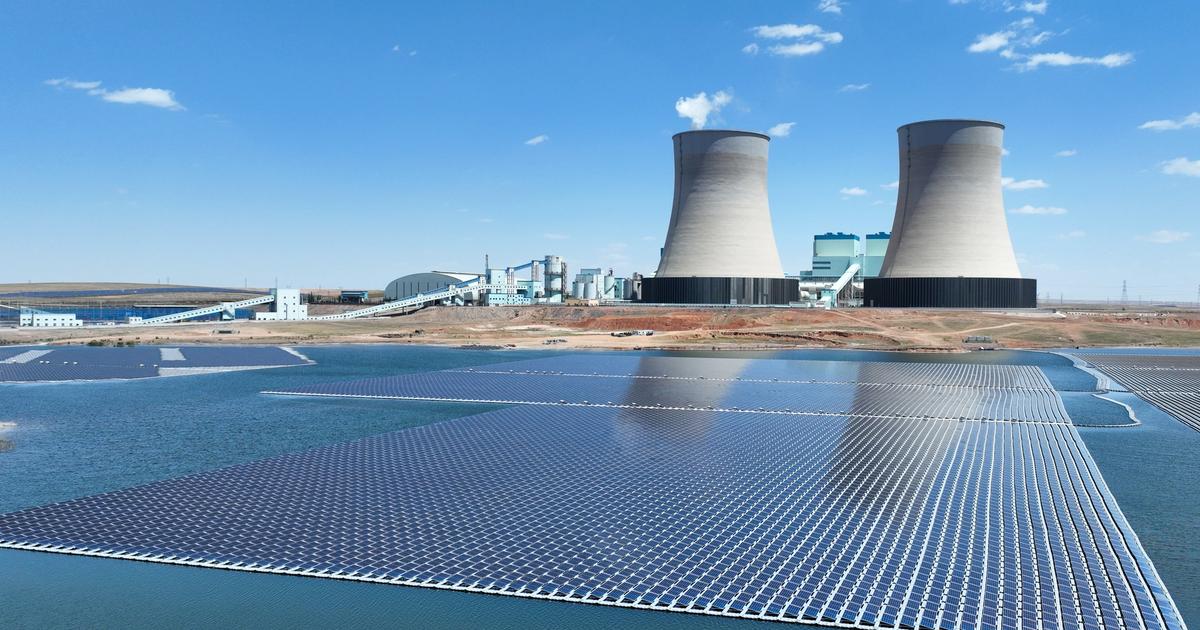An Alliant Energy solar farm near Dubuque on October 4, 2022. (Nick Rohlman/The Gazette)
CEDAR RAPIDS — The Linn County Board of Supervisors unanimously advanced tighter restrictions in its ordinance regulating utility-scale solar projects Tuesday, signaling support for the policy changes intended to balance the interests of farmers and neighbors with supporting projects that will generate more renewable energy.
In a room at the Jean Oxley Public Service Center packed with more than 50 residents, solar energy project representatives and union workers, the three-member board passed the ordinance on its first reading and provided feedback on a score card that is proposed to be used to assess utility-scale solar project applications.
With a moratorium pausing new solar project applications slated to expire after Sept. 30, county staff have been working since last year to draft new ordinance language.
Changes would not apply to previously approved projects. The supervisors approved three controversial utility-grade solar installations in 2022 — one near Coggon and two related projects near Palo.
The 640-acre site near Coggon is developed by Idaho-based Clenera and the Central Iowa Power Cooperative. There also is a total of more than 1,000 acres for two projects from NextEra near the decommissioned Duane Arnold Energy Center nuclear plant near Palo.
Earlier this year, four renewable energy review committees drafted statements pointing county staff to areas of the ordinance that could be changed, studying four areas: good neighbor practices, battery energy storage systems, life cycle costs and balancing agriculture and solar.
Planning and Development Director Charlie Nichols said most people who commented seem to have something against the ordinance, which he said speaks to the nature of the compromise.
“We had people from both sides there and every statement was a compromise,” Nichols said. “So nobody’s completely happy with those statements, but they do represent people with different views on these projects trying to work together and come up with something they can all be a little bit unhappy with that nobody is completely unhappy with.”
Ordinance changes
The new ordinance language keeps setback requirements applied to previous projects. On the same subject : Green Power Gets Pricier After Years of Declines. Setbacks must be at least 50 feet from property lines and 300 feet from dwellings unless waived by the property owner.
It requires screening within 1,000 feet of the project and noise levels not exceeding 55 decibels. The applicant would have to provide documented plans for operation and maintenance, agricultural impact and decommissioning and site restoration, as well as an emergency response plan for the battery energy storage system.
Since unveiling the new ordinance language, Nichols said further changes were made based on Planning and Zoning Commission feedback. Those changes:
Clarify requirements for a preconstruction road surveyDefine drainageways and eliminate language for an “immediate” requirement to repair themEliminate a requirement that unused equipment be removed from the site so developers can store panels or replacement equipment but remove other obsolete equipmentApplicants seeking rezoning for a renewable energy overlay district would face additional notification requirements of property owners and tenants. Within 14 days of a rezoning application being filed, they would have to notify residents within 1,000 feet of the project. The developer would also have to hold a public information meeting at a reasonably accessible location.
The supervisors favored their board taking on the responsibility for reviewing conditional use permits for stand-alone battery energy storage stations instead of the supervisor-appointed Board of Adjustment doing so.
Supervisors Ben Rogers and Kirsten Running-Marquardt wanted these decisions to be with the board because they are elected officials.
“Because this issue is so hot, because this has people on both sides of the issue with very passionate opinions this … moving it away from us, I think, doesn’t allow for the public access on this issue that I would like,” Running-Marquardt said. “We are the ones that are elected and we deserve to receive the feedback on this type of issue.”
Other ordinance changes are being discussed including defining “repowering” and what would trigger that — essentially replacing parts of the solar installation — to avoid the developer undergoing an entire site review.
The supervisors are also weighing the minimum solar panel height and may reduce it from the 32 inches proposed in the new ordinance. There was also some discussion of whether noise levels should be measured from a property line or dwelling.
Scorecard would give ‘points’ for vegetation, less grading
The supervisors discussed the score card but did not formally vote to adopt it Tuesday It was the subject of some of the more intense scrutiny during public comment. Read also : California landfills are filling up with toxic solar panels. The vote on the score card will take place with the third and final ordinance reading.
Under the draft score card, developers of a utility-scale solar installation would need 100 points for a project to pass. They could reach the threshold by earning points across different metrics:
Planned number and percentage of species in entire site’s vegetative cover Having an approved vegetation plan and agricultural impact mitigation planLocating the site in a medium or high Corn Suitability Rating Area, with more points being deducted the higher the CSRUse of agrivoltaic practices — combining crops and solar — on the siteIncluding flowering plants in the vegetative coverPlanned seasons with at least three blooming species presentHaving a low percentage of the site gradedExceptional “Good Neighbor Practices,” minimizing non-participating dwellings within 300 to 1,250 feet of project boundaries
There were mixed opinions on the use of CSR on the score card. It was first proposed by the renewable energy review committee focused on the balance between agriculture and solar interests, whose members wanted to identify a way to increase renewable energy generation while considering the needs of farmers and for agricultural processes.
Others were concerned it would punish landowners who they said should be free to determine how their land is used when developers have to decide where to build a project.
“It just seems like a lot of points and it seems like it’s pretty unrealistic to get 100 percent participation” from landowners, said Beth Dunkel, of Center Point, who is a non-participating landowner who lives near the Duane Arnold phase III project.
Kimberly Dickey, the project director for Duane Arnold Solar, said NextEra officials have taken time while the moratorium has been in effect to contemplate improvements for future projects. She said NextEra is looking at offering participation agreements with adjacent landowners and is piloting a tenant farmer focus group to consider a compensation package for farmers.
Marion resident Swati Dandekar, co-chair of the Bright Future Iowa group, which has advocated for solar projects, said the new ordinance was “very, very restrictive” and asked the supervisors to drop the score card.
“Many counties across Iowa are watching what we are doing,” Dandekar said. “We need to make sure we do it right. We have to have an ordinance that still welcomes solar, an ordinance that will encourage economic development.”
What’s next?
The supervisors will continue to meet with staff to discuss any possible ordinance changes debated during Tuesday’s public hearing. The second and third readings are slated for the supervisors 10 a.m. Sept. 13 and 20 meetings in the formal boardroom of the Jean Oxley Public Service Center, 935 Second St. SW in Cedar Rapids.
Comments: (319) 398-8494; marissa.payne@thegazette.com


